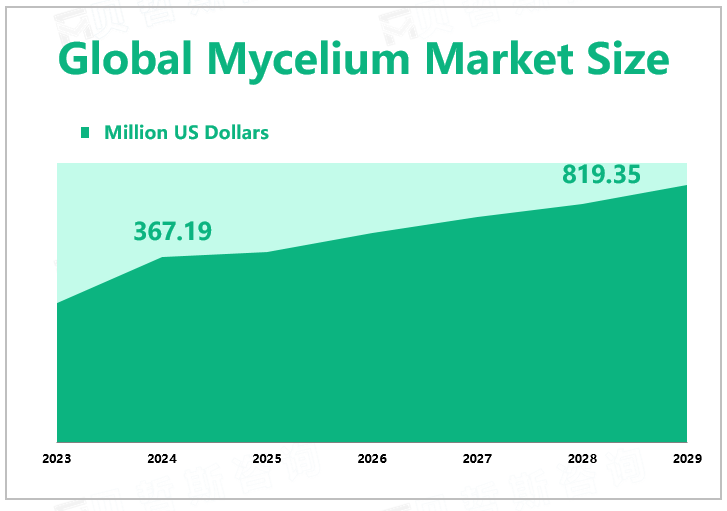According to Global Market Monitor, the global mycelium market size is $367.19 million in 2024 and is expected to grow to $819.35 million by 2029.
Mycelium is the root-like fibers of fungi that grow beneath the surface of the ground, appearing as a frost-like growth beneath leaves and bark and growing into a dense network for sprouting mushrooms. Mycelium has a robust fiber structure that may be used to make clothes, food, building materials, and packaging.
Market News
Mycelium can be a viable alternative to replace expanded polystyrene packaging. Mycelium was also shown to be an interesting support material for electronic circuit boards instead of commonly used acrylic plastics or as e-textiles and reactive fungal wearables. Mycelium material properties that are appreciated features for electronic support applications are their heat and thermal resistance, lightweight, modulable shape, and hydrophobic nature.
In early 2024, California-based biotech innovation company MycoWorks announced that its first commercial-scale plant had produced more than a thousand Fine Mycelium™ mycelium materials, exceeding the quality of the company's pilot plant in California. MycoWorks says the plant's output has been booked by customers for the past two years. With the increasing environmental awareness of consumers, the transformation of many luxury brands and fashion brands to bio-based materials has promoted the innovation of fabrics through "vegan leather". French luxury brand Hermes, for example, has launched a vegan leather handbag using an amber-colored mycelium leather material called Sylvania that MycoWorks developed specifically for it. Several sportswear brands, including Adidas, Stella McCartney, Lululemon, and others, have also partnered with other biotech companies to launch similar mycelium leather clothing.

Mycelium Market Opportunities Analysis
With the continuous development of the industrial economy and the rapid increase of social demand, plastic has become an indispensable material element in industry, agriculture, national defense construction, and modern life. Plastic products not only bring convenience to people's lives, but also the environmental pollution caused by waste plastic has become one of the most important environmental problems faced by the sustainable development of human society. According to statistics, of the 8.3 billion tons of plastic produced by human beings, 6.3 billion tons of plastic have completely become waste. Only 9% of these waste plastics are recycled, 12% are incinerated, and the remaining 79% of waste plastics are buried in landfills or accumulated in the natural environment. At the same time, the pace of plastic production shows no signs of slowing down. According to the current trend, the world will have about 12 billion tons of plastic waste by 2050, posing a serious threat to the earth's ecological environment and human health.
In the future, mycelium materials are likely to become more diverse and ubiquitous, with little noticeable change. This is not only due to the expected increase in research and development efforts for this novel material but also because the transition from gasoline-derived synthetic polymers and animal leather will become a growing environmental necessity.
|
By Type |
Raw |
|
Processed |
|
|
The raw segment contributes the largest market share. |
|
|
By Application |
Food Industry |
|
Packaging Industry |
|
|
Leather Industry |
|
|
Construction Industry |
|
|
The food industry segment occupies the biggest share. |
We provide more professional and intelligent market reports to complement your business decisions.